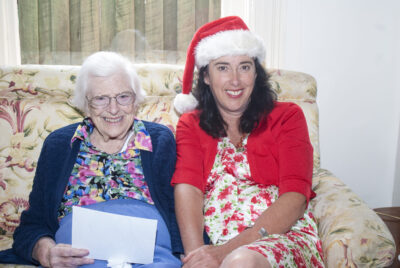For around one third of residents in aged care homes, this will be their last Christmas. Yet many residents will not be able to celebrate with families and loved ones, even though Australia has transitioned to Covid-normal.
An aged care home in Melbourne informed families that residents would not be able to have guests join them for Christmas lunch due to “Covid-safe reasons”. The home also announced that while residents and staff could enjoy a Christmas party of afternoon tea with carols, there would be no entertainers and, again, families would not be able to join the celebration.
Another aged care home in Queensland has banned Christmas trees, just to be safe. And on it goes, from the bizarre to the ridiculous.
When the pandemic took off in March, all non-essential staff were banned from entering aged care homes. This included family members who regularly cared for their loved ones by helping with feeding, toileting and so on. This decree was in defiance of the chief medical officer’s advice, which at that time was only to limit the number of visitors in aged care homes.
Providers claimed a total lockdown was necessary “to save lives”. However, families who were locked out were far more afraid that their loved ones would die of neglect, not Covid.
In their special report the aged care royal commissioners expressed concern about providers’ decision to keep residents locked in and families locked out. In several aged care homes, residents were confined to their room, some for more than two months. Taking away an older person’s liberty by confining them to their rooms was profoundly damaging to their mental and physical wellbeing. Some legal experts have suggested it may also have been illegal.
The royal commissioners also noted that the reduction in visitors had made it difficult for staff to meet the day-to-day care needs of residents. This admission points to how heavily private providers rely on the unpaid work of family members/friends and volunteers to help with meals, exercise and care for their loved ones.
In May, aged care providers and the federal government released the “Aged Care Visitor Access Code”. The guidelines were developed after consultation with the usual government-funded consumer groups. But there was no consultation with family members who were locked out.
The guidelines failed to provide a nationally consistent policy about who can visit and when. Instead, individual private aged care homes made their own rules. Not surprisingly, there have been more than 900 complaints about visitor restrictions made to the regulator, the Aged Care Quality and Safety Commission.
If providers had listened to family members, they would have known that they were not asking for an open house. Instead, they wanted a humane lockdown that allowed relatives who provided regular care for residents to continue to provide that care. Everyone who entered an aged care home – both staff and visitors – would have undertaken the same infection control measures.
In May, the federal government announced $205m to contribute to the extra costs of managing Covid, including “screening visitors”. Yet most aged care homes continued to lock out families. In some cases, that lockout only ended recently, six months after the funding was provided.
Despite the strict lockdowns, there have been outbreaks in 223 aged care homes, with 678 residents dying from Covid. Staff were responsible for each outbreak, despite many coming to work when they were asymptomatic. Clearly, procedures to protect residents failed.
A 15-minute rapid antigen screening test is available that would allow providers to do real-time testing of all visitors and staff before they enter the aged care home. Although not as accurate as PCR tests, such testing in conjunction with training in infection control would give some peace of mind to all when families visited their loved ones in aged care.
Rather than fund rapid testing, the federal government has funded “visitation assistants” to work in aged care homes for eight weeks. The aim is to place into aged care homes large numbers of people who have lost jobs in other sectors. Applicants merely require a “caring, empathetic and friendly personality”. So far 150 people have undertaken the 10-hour training, with some three-quarters from the airline industry.
Aged care minister Richard Colbeck has also funded a grief and trauma package. This $12.4m would have been better spent on teaching families infection control so they could have safely visited their loved ones.
Not surprisingly, residents’ depression, anxiety, confusion and loneliness increased due to the absence of visitors and long confinements in their rooms. In response, the federal government recently created a new Medicare benefits schedule item for mental health for residents in aged care homes.
In Wednesday’s pre-Christmas economic update the federal government also re-announced $63.3m to improve access to allied health and mental healthcare for people in residential aged care. Older people living in aged care homes will now have access to 20 subsidised sessions with a psychologist – the same entitlements as older people in the community.
While access to mental health services will be important, releasing residents from their rooms, allowing them to leave the aged care home and ensuring their loved ones can visit will undoubtedly improve their mental health. With the transition into Covid-normal, staff, residents and families should celebrate Christmas like there is no tomorrow. They deserve it.
First published in The Guardian on 16 December 2020
